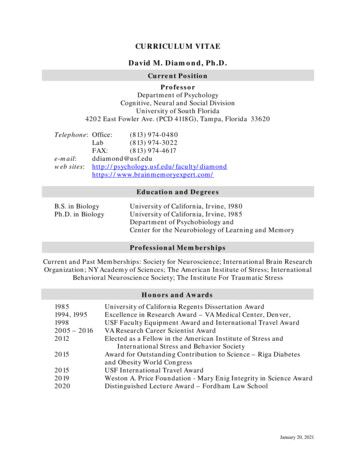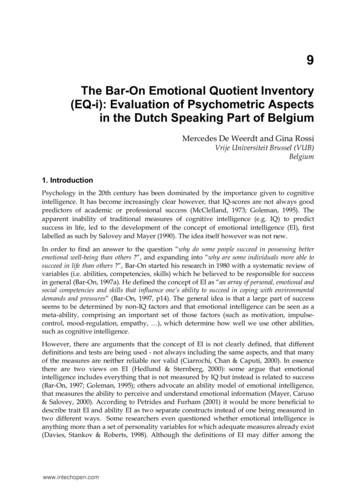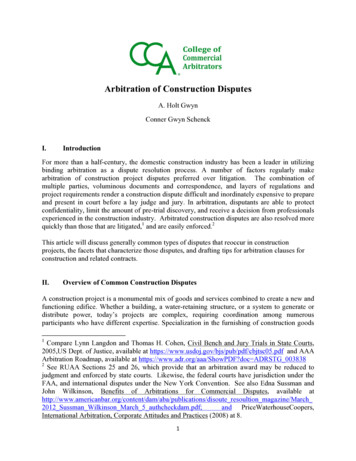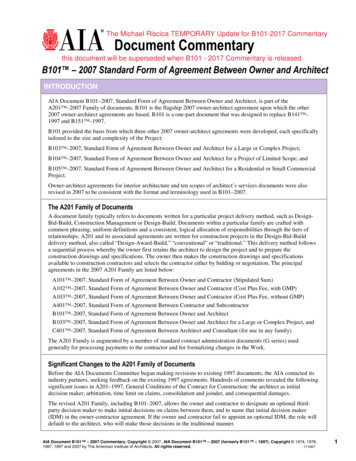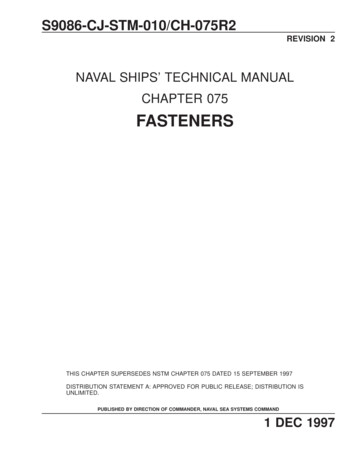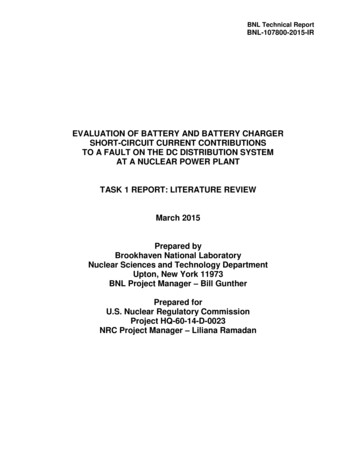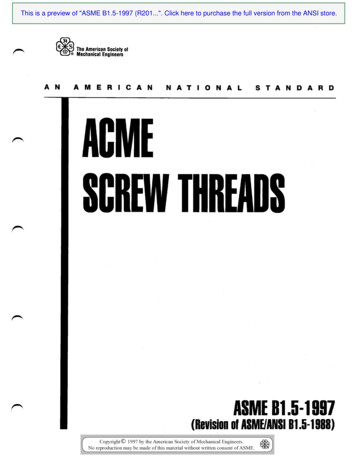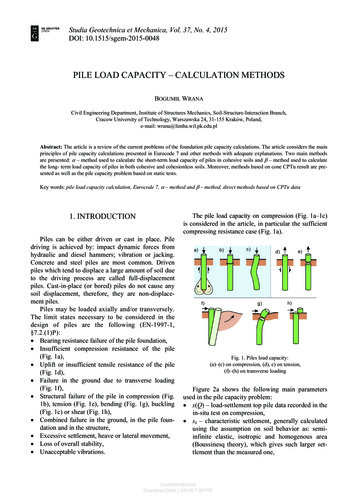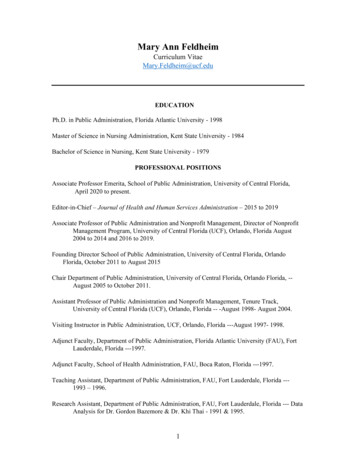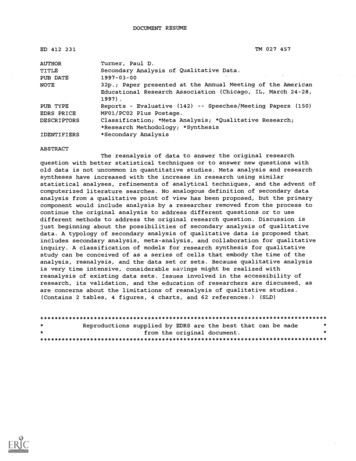
Transcription
DOCUMENT RESUMETM 027 457ED 412 231AUTHORTITLEPUB DATENOTETurner, Paul D.Secondary Analysis of Qualitative Data.1997-03-0032p.; Paper presented at the Annual Meeting of the AmericanEducational Research Association (Chicago, IL, March 24-28,1997).PUB TYPEEDRS PRICEDESCRIPTORSIDENTIFIERSSpeeches/Meeting Papers (150)ReportsEvaluative (142)MF01/PCO2 Plus Postage.Classification; *Meta Analysis; *Qualitative Research;*Research Methodology; *Synthesis*Secondary AnalysisABSTRACTThe reanalysis of data to answer the original researchquestion with better statistical techniques or to answer new questions withold data is not uncommon in quantitative studies. Meta analysis and researchsyntheses have increased with the increase in research using similarstatistical analyses, refinements of analytical techniques, and the advent ofcomputerized literature searches. No analogous definition of secondary dataanalysis from a qualitative point of view has been proposed, but the primarycomponent would include analysis by a researcher removed from the process tocontinue the original analysis to address different questions or to usedifferent methods to address the original research question. Discussion isjust beginning about the possibilities of secondary analysis of qualitativedata. A typology of secondary analysis of qualitative data is proposed thatincludes secondary analysis, meta-analysis, and collaboration for qualitativeinquiry. A classification of models for research synthesis for qualitativestudy can be conceived of as a series of cells that embody the time of theanalysis, reanalysis, and the data set or sets. Because qualitative analysisis very time intensive, considerable savings might be realized withreanalysis of existing data sets. Issues involved in the accessibility ofresearch, its validation, and the education of researchers are discussed, asare concerns about the limitations of reanalysis of qualitative studies.(Contains 2 tables, 4 figures, 4 charts, and 62 references.) ***********************************Reproductions supplied by EDRS are the best that can be madefrom the original ***************************************
Paul D. TurnerUniversity of Nebraska Medical CenterDepartment of Family Medicine600 S. 42nd St., Box 983075Omaha, NE 68198-3075(402) 559-6758e-mail: pturner@mail.unmc.eduPERMISSION TO REPRODUCE ANDDISSEMINATE THIS MATERIALIN OTHER THAN PAPER COPYHAS BEEN GRANTED BYU.S. DEPARTMENT OF EDUCATIONOffice of Educational Research and ImprovementEDUCATIONAL RESOURCES INFORMATIONCENTER (ERIC)Xr-This document has been reproduced asreceived from the person or organizationoriginating it.Minor changes have been made toimprove reproduction quality.-Pau l D. --i-vury\-e vTO THE EDUCATIONAL RESOURCESINFORMATION CENTER (ERIC)Points of view or opinions stated in thisdocument do not necessarily representofficial OERI position or policy.Secondary Analysis of Qualitative DataA Roundtable Discussion1997 Annual AERA ConferenceChicago, IL** Do not reproduce without the permission of the author.BEST COPY AVAILABLE2
Secondary Analysis of Qualitative DataQuantitative and Qualitative PerspectivesQuantitative Secondary Data AnalysisThe reanalysis of data for the purpose of answering the original research question with betterstatistical techniques or answering new questions with old data (Glass 1976).Meta-Analysis"The statistical analysis of a large collection of analysis results from individual studiesfor the purpose of integrating the findings" (p.3).In essence, meta-analysis is a term describing a variety of statistical procedures used toaggregate and quantitatively summarize the results of multiple studies on a commontopic. The technique summarizes a set of empirical findings (usually in terms of ameasured "effect size") and tests their distribution for sampling error as an explanationfor the inconsistency. Some methods (i.e., Hunter and Schmidt 1990) further adjust forcorrection of results due to statistical or methodological artifacts inherent to the studies.Research SynthesisResearch synthesis (integrated research review) is a process of combining and comparingempirical research for the purpose of creating generalizations. This process includes: thea priori formulation of hypotheses and problems; the search and evaluation of theprimary studies involved, and; the analysis and interpretation of the integrative studies.Research syntheses almost always (a) pay attention to relevant theories, critically analyzethe research they cover, (b) try to resolve conflicts in the literature, and (c) attempt toidentify central issues for future research. The statistical analysis in a researchsynthesis is what Glass termed meta-analysis (Cooper and Hedges 1994).Meta-analyses have proliferated since Glass's original 1976 article introducing the concept.Figure 1 below illustrates the growth of meta-analyses in the literature compared between thesocial (education, psychology, and sociology) and health sciences.3
Figure 1: Health and Social Sciences Meta-Analyses Published from 1990199119921993Year41* Health "}* Social Sciences* From Evaluation and the Health Professions, 18(3), R.B. Bausell et al., 1995, p.246.Three events have been credited for this proliferation of quantitative literature synthesis in recentyears (Cooper 1989):1. The growth of research utilizing similar statistical analyses2. The advent of the computerized literature search3. The refinement of statistical procedures for aggregating similar studies (i.e., meta-analysis).The limitations and related misunderstandings surrounding meta-analyses are just beginning tobe realized and discussed as summarized in Table 1 below.2
Table 1: Issues Regarding Meta-AnalysisSourceIssuesSelection of Studies(Jeng et al. 1995; Khan, Daya, & Jadad 1996)Publication BiasData Source (i.e. from the literature vs. field)Quality of StudiesMissing DataMethodology(Hasselblad et al. 1995)Which method of aggregation should be used?Should quality measures of individual studies be used?How are different forms of measures combined?Should a Fixed-Model or Random-Model be used?There is one best meta-analytic method.Meta-analysis is better than a narrative review.Meta-analysis culminates the research in a givendomain.The most important product of a meta-analysis is theaverage effect size.Common Misunderstandings(Bangert-Drowns 1995)In essence, a meta-analysis or research synthesis is a study of studies and should be thought ofmore as a perspective than a statistical technique. It is not superior to primary research ornarrative literature review, but offers a broader interpretation of disparate studies by facilitatingthe identification of specific patterns.SynthesisAn activity or product of an activity where some set of parts is combined or integratedinto a whole. It involves some degree of conceptual innovation, or employment ofconcepts not found in the characterization of the parts as a means of creating the whole(Strike and Posner 1983).Thus, all syntheses are inductive, whether quantitative or qualitative in nature. However at thistime the most developed ones are inductive and positivistic (i.e., meta-analysis and quantitativeresearch synthesis). Syntheses which are inductive and interpretive are just beginning to receiveattention.3
Qualitative Secondary Data AnalysisWhile no analogous definition of secondary data analysis has been offered from the qualitativeperspective, the primary component would include the following:Analysis of qualitative data by one removed from the process with the purpose of eithercontinuing the original research analysis, addressing different questions not addressed inthe original research, or using different methods to address the original researchquestions.Discussion is just emerging on the possibilities of secondary analysis with qualitative data. Atthis time, the literature includes three primary discussions on the concept (Noblit and Hare 1988;Thorne 1994; Estabrook, Field, and Morse 1994). Table 2 summarizes the implied typology ofthe current literature.Table 2: Qualitative Secondary Data Analysis TypologyDescriptionSecondary Analysis StrategiesAnalytic Expansion(Thorne 1994)The primary researcher uses the original database to progress to the next level of analysis orexplore new and evolving questions as theory emerges.Retrospective Interpretation(Thorne 1994)New or unanswered research questions are explored from the data which were not fullyArmchair Induction(Thorne 1994)Textual or content analysis by those experienced in theory development and talents lieAmplified Sampling(Thome 1994)The development of broader theories through comparison of several distinct andCross-Validation(Thorne 1994)Other databases are used by the researcher to confirm or discount new findings and/orMeta-Ethnography(Noblit & Hare 1988)The comparative textual analysis of published field studies through the translation ofqualitative studies into one another, and as such, avoids the aggregation of studiesexamined or explained in the original research study.therein, rather than the phenomenon under investigation.theoretically representative databases.suggest patterns related to his/her own sample and research.attempting to create generalizations and general conclusions.Aggregated Analysis(Estabrook et al. 1994)Aggregation, analysis, and synthesis of the findings (i.e., not the original data) of multiplestudies for the primary purpose of developing mid-range theory.4
Conceptually, I would propose a typology more intuitive to that of a research synthesis whichwould include three basic approaches as illustrated in Figure 2:Figure 2: Approaches to Qualitative Research SynthesisQualitative ResearchSynthesisMeta-analysisSecondary AnalysisCollaborationSecondary Analysis: Analysis of an existing qualitative database, or databases, for the purposeof reviewing the literature, answering the original research question(s)using different methods, or answering new questions with "old" data.Meta-Analysis:An analysis of the results or original data from multiple studies. Theinductive integration of interpretive studies (published or unpublished) sothey may be reduced, compared and translated as a way of synthesizingknowledge.Collaboration:The joint intellectual effort involving the on-going interaction ofqualitative researchers, and any stakeholders outside the context of thestudy (e.g., policymakers, evaluators, practitioners), contributing to theinterpretive process of qualitative inquiry.5
8SimultaneousAnalysisAfter-the-factAnalysisNo sification ofResearch Syntheses:Single Data SetMultiple Data Sets9Data Source
Review of ModelsCell 1: After-the-fact analysis/no reanalysis/single data setA critical review of a study by someone who does not have access to the primary data andconsequently critiques/discusses the primary research based upon:methodological considerationsexamining the data as presented (e.g., text, narratives, etc.)interpreting the data which is presentedEx.:Editorial/review in a journal in response to a published article or book.Hickson, G.B., Clayton, E.W., Entman, S.S., Miller, C.S., Githens, P.B., WhettenGoldstein, K., & Sloan, F. (1994). Obstetricians' prior malpractice experience andpatients' satisfaction with care. Obstetrical & Gynecological Survey, 50, 351-353.Cell 2: After-the-fact analysis/data reanalysis/single data setI perceive this cell representing where most of the qualitative secondary analyses have and willoccur, however from two different perspectives or goals:Using the primary data to either continue investigation of the original research questionor to address new research questions. This may either involve the re-analysis of theprimary data of a single study or of a large archived qualitative database.Ex.:Handout (PIPP)Murdock, G. Outline of Cultural Materials. Human Relations Area Files, Inc.New Haven, CT.Murdock, G. Outline of World Cultures. Human Relations Area Files, Inc.New Haven, CT.610
Mead, J.V. (1993). A guide to the Teacher Education and Learning To TeachDatabase. (Technical Series 93-2). East Lansing: Michigan State University,National Center for Research on Teacher Learning.McGrath, J.W. (1991). Biological impact of social disruption resulting fromepidemic disease. American Journal of Physical Anthropology, 84, 407-419.The audit of an entire study may be one goal of a secondary analysis for the purpose ofestablishing credibility (e.g., validity). An audit may be either independent of theprimary investigator(s) or an actual component of the primary research design. Auditsusually involve a series of steps similar to those proposed by Schwandt and Halpern(1988) for evaluation studies.Ex.: Handout (LB506 and AHCPR)Cell 3: Simultaneous analysis/no data reanalysis/single data setThis cell represents two potential applications. The first is what McCracken (1988) refers to as"commissioned" qualitative research in which an administrator conducts the investigation from adistance through directing the work of others. As defined, "This may be a project director of alarge omnibus project or the party charged with commissioning single, purpose-built pieces of adhoc research" (p.59).Ex:Handout (AHCPR).The second application is more along the line of consultants and research advisory boards whoare contracted to assist with a research study. The optimal use of such individuals is that assimultaneous "reviewers" throughout the time frame of the study - posing alternativeexplanations of interpretations, critiquing data collected and analyzed, and providing insightfrom the interpretations shared with them.A more commonly used approach is to hireconsultants for special sessions or retreats with the primary investigators for similar reasons.Ex.:Handout (AHCPR.)'ILL
Cell 4: Simultaneous analysis/data reanalysis/single data setWithin this cell is where most qualitative collaborative research occurs. This most likelyinvolves a team approach where division of labor is accomplished at different levels. Forexample, you may have specific investigators responsible for the fieldwork, while others foranalysis. It may also be feasible for the analysts to work separately, thus allowing the pursuit ofdifferent questions/issues they view as important.Ex.:Handout (AHCPR)Liggett, A.M., Glesne, C.E., Johnston, A.P., Hasazi, S.B., & Schattman, R.A. (1994).Teaming in qualitative research: Lessons learned. Qualitative Studies in Education,7(1), 77-89.McVea, K., Crabtree, B.F., Medder, J.D., Susman, J.L., Lukas, L., Mcllvain, H.E.,Davis, C.M., Gilbert, C.S., & Hawver, M. (1996). An ounce of prevention? Evaluationof the "put prevention into practice" program. Journal of Family Practice, 43, 361-369.Vogt, E.Z. & Albert, E.M. (Eds.) (1967). People of Rimrock: A Study of Values inFive Cultures. Cambridge, MA: Harvard University Press.Whiting, B.B. & Whiting, J.W. (1975). Children of Six Cultures: A Psycho-CulturalAnalysis. Cambridge, MA: Harvard University Press.Cell 5: After-the-fact analysis/no data reanalysis/multiple data setsThis cell is most analogous to the quantitative meta-analysis and literature synthesis through itsfocus upon synthesizing the results of multiple studies/databases. As with its quantitativecounterpart, there are specific issues needing to be addressed or acknowledged as identifiedearlier in Table 1, and summarized as follows:Sampling: how and which studies are chosen (e.g., published vs. unpublished studies)Quality control: deciding which studies to include and which to exclude based on theirqualityRelevance: after deciding on quality, then one must decide which high quality studiesare of greatest relevance.
Results: how does one deal with inconsistent findings and missing data.The problems are accentuated in this cell, as opposed to the next cell (Cell 6), because thesecondary analyst is not privy to the original data of the studies.Ex.:Corbin, J. & Strauss, A.L. (1987). Accompaniments of chronic illness: Changes inbody, self, biography, and biographical time. Research in the Sociology of Health Care,6, 249-281.Cell 6: After-the-fact analysis/data reanalysis/multiple data setsThis cell is more along the line of Noblit and Hare's Meta-ethnography (1988) in that thesecondary analyst is interested in synthesizing multiple studies through the analysis of theoriginal data. Here the key issue becomes how to combine the data of studies and is most usefulfor those wishing to review the qualitative literature on some area of interest.Cell 7: Simultaneous analysis/no data reanalysis/multiple data setsThis cell is rarely realized in contemporary qualitative researcher. It basically consists of asecondary analyst or "meta-analyst" who is commissioned to oversee two or more related studiesconcurrently under investigation. This could possible occur in the larger national fundingagencies and would have some definite advantages which will be discussed in the final cell.Cell 8: Simultaneous analysis/data reanalysis/multiple data setsThis model is more along the lines of programmatic research and consists of running two or morestudies back-to-back, or consecutively, beginning one study immediately after the other study'sdata collection and analysis are completed, but no final report has been published. Theadvantage to this model is that one can learn from the mistakes and insights of the precedingstudy to help inform the subsequent one. They also prove helpful for purposes of generalizationsand theory development through replication and modification. However, a limitation is that suchstudies may be prohibitively expensive.Ex.:Handout (DOPC, LB506 study, and AHCPR)
Rationale1. Review of LiteratureResearchers may wish to gain new knowldege by comparing across studies within a specificsubject area of interest, or even reanalyze a specific study of interest. The knowledge and insightgained by many qualitative studies is not static. The knowledge gleaned in the original researchmay be progressed by the new insight or "lens" of other researchers. Likewise, such progress ofknowledge may be realized through the passing of time. New insights, theories, and studies mayevolve which are very pertinent and give an added perspective useful to the original research.Secondary analysis would provide the opportunity to re-enter the original research and develop anew layer of analysis.2. EconomyQualitative research is very time intensive, beginning well before the data collection (e.g., issuesof gaining access) and continuing after (e.g., analysis and verification). It is not uncommon for aqualitative database to represent years of work by the primary investigator and substantialfunding through a variety of sources (e.g., universities, grant agencies). Considerable time,money, and personnel could be saved through secondary analysis of an already existent data baseor a research team approach.This may becoming a critical and viable issue for qualitative researchers. The attenuation offederal funding for research appears inevitable. The implications, according to some, is that thefuture for many researchers lies in private industry funding (Morone and Belkin, 1995). Suchfunding frequently comes with inherent agendas which most likely include the economy ofresources and a historical predominance of quantitative research. While qualitative research isrecognized as useful, it is often viewed as prohibitive in terms of time, personnel and money.Future funding for research, regardless of methodology, will most likely have a strongcomponent based on economic restraint related to what useful outcomes are generated by suchresearch.10
3. AccessiblityGaining access through gatekeepers can be difficult, depending on the focus of the study.Analysis of an already existent database which has addressed such an issue may be advantageousin such cases. Likewise, collaborating with individuals with access to an otherwise restrictivefield of interest may be the only way of obtaining the data necessary for a specific study.There are cases which involve the study of rare events or infrequent cyclic occurrences in a lifecycle of an individual or sample of interest.Secondary analysis may provide a uniqueopportunity to access otherwise unique and scarce data.4. Verification (Validation) Through TriangulationTriangulation is not a tool or a strategy of validation, but an alternative to validation (Fieldingand Fielding 1986, Denzin 1989a, 1989b, Flick 1992). Denzin (1978) and Janesick (1994)identified five types of triangulation: data, investigator, theory, methods, and disciplinary. Thecombination of multiple methods, data types, theory, perspectives and observers in a single studyis best understood, then, as a strategy that adds rigor, breadth, and depth to any investigation.Unfortunately, many qualitative researchers primarily think of triangulation in terms of datatriangulation and more recently, secondarily as methodological triangulation. With regards toinvestigator and interdisciplinary triangulation, such approaches are usually incorporated into anaudit as a "post hoc" form of verification. I believe that such forms of triangulation whenincorporated into the methods of a research synthesis aid in verification by narrowing thedistance between the field and the analyst(s).5. Education/TrainingThe reanalysis of data from original investigations can be fundamental in the training ofresearchers, evaluators, and practitioners. In fact, it may be more ubiquitous to training than toresearch per se. If such use of secondary analyses are successful in educating others regardingthe solutions, or possible solutions, to the problems which arise in collecting, analyzing, andinterpreting data, a subsequent outcome may be the improvement in the quality of primaryresearch.
Limitations/Issues1. Field AbsenceWith qualitative studies, the researcher is the research instrument (Guba and Lincoln 1981;Patton 1990; Bogdan and Biklen 1992; Marshall and Rossman 1995). One brings their ownunique experiences, perspective or "lens", bias, and interpretive style to the collection of data andanalysis. The absence of the secondary data analyst from the data collection raises seriousquestions regarding the misinterpretation of the data.There may be no substitute for theintimacy and context one develops with their data when it comes time to "make sense" of it at theanalysis stage.I would suggest that this problem may be the result of the specific qualitative strategy used. Asdiscussed by Creswell (1995), the importance of the research's presence in the study and therelative weight given to description varies with different strategies (Figure 4).Figure 4: A Comparison of Five StrategiesRelative Weight for DescriptionMinimalPCGTSubstantialBEResearcher's PresenceBackgroundB BiographyGTCPC Case StudyEForefrontE Ethnography GT Grounded Theory P Phenomenology*From Qualitative Strategies of Inquiry and Design Procedures, J.W. Creswell, 1995.1216
For example, substantial weight on thick description is seen with a case study and ethnographywhile less is emphasized in phenomenology and grounded theory. The presence of the researcherfrom data collection to the actual write -up-is seen as being in the forefront with an ethnographywhereas, the researcher is more in the background with a grounded theory and phenomenologicalstudy. Such issues need further investigation, but at this time, it appears intuitive that specificqualitative strategies may be more accessible to secondary analysis than others.2. Lazy ResearchThorne (1994) describes "lazy research" as data sets which are used due to their convenience, andas a result, become overly available and overused. This often will result in exaggeration andmisinterpretation of any of the peculiarities of the overused sample database.I would also extend this to those researchers, for whatever reason, merely want to avoid the timeand inconvenience of data collection. This is also not uncommon in the quantitative arena thereare those who do not want to go through the inconvenience of random assignment, and thereforewill perform excessive covariance procedures (e.g., ANCOVA, MANCOVA) in attempts tominimize any systematic bias in the treatment groups. Frequently, this may cause a subsequentdecrease in the statistical power and findings. Researchers needs to defend their means ofanalysis regardless of methodology.3. Ethical IssuesAs previously discussed, the rationale for secondary analysis relate to economy and accessissues. The researcher may be able to avoid such issues as gaining access, identifying willinginformants, and a variety of IRB-based requirements. However, if the secondary analysis isbeing conducted with a new and different research question than the original research, one shouldnot assume that the original informants' complied consent is universal or omnipresent. Thisraises specific ethical considerations not only for the secondary analyst, but also the originalresearcher who is making his/her data set available for such purposes.1317
ConsiderationsI would propose the following six questions be considered by any qualitative researchercontemplating a secondary analysis.1. What is the specific qualitative strategy employed by the study?Due to the pivotal and variable role of the researcher in the different qualitative strategies, certainones may be conceived as more viable than others. A continuation of this question is to alsoevaluate the qualitative design for any flaws which would interfere with the data analysis.Questions needing to be asked are: Does the strategy match the research question?; Are theappropriate types of data present for the specific strategy?; and, Are appropriate techniques usedby the data collector?2.Who was responsible for the original data collection and will they be available to youthroughout the analysis?At the risk of being redundant, the researcher is the research instrument. The training andexpertise of the researcher conducting the data collection is critical. Also, since numerousquestions or problems may occur during the secondary analysis, one may need to ask the datacollector specific questions regarding the data which only he/she could answer.3. What is the quality of the data?The data needs to be carefully scrutinized for its representiveness of the particular qualitativestrategy and its overall quality for credibility reasons.4. What is the format in which the data is stored?Data accurately transcribed and imported into a qualitative software package is more accessible,organized, and easier to work with than the researcher's original data and notes, or their remnantsafter the original analysis. Through the increased use of computer software for data analysis,secondary data analysis may already be currently used more than realized.
5. Are there supplementary data types which may be helpful?As identified by Denzin (1978), there are four basic types of triangulation; data, investigator,theory, and methodological triangulation. The importance of data triangulation cannot be overemphasized with regards to secondary data analysis. The use of all types of data collected,regardless of the intended or original use in the study, should be evaluated for their usefulness innarrowing the distance between the data collection and the analyst.6. How will the final product be written and used?The question of how, or whether, the use of secondary data analysis will be discussed in the finalproject is difficult to answer. With the emphasis by editors for parsimony and the descriptiveand interpretive demands of qualitative studies, authors must frequently be concerned about thelength and content of their manuscript. Shortening the methodology section for the sake ofkeeping the narratives, descriptive data, and interpretive analyses, is probably the path of leastresistance. It is much easier, and raises less methodological questions, to explain themethodology from the standpoint of a research "team" approach, rather than discussing the roleof each. Until more inquiry and discussion on the use of secondary analysis is realized, itsacknowledgment in the literature will most likely remain obscured.1519
References/Reading ListMeta-Analysis and Research SynthesisBangert-Drowns, R.L. (1995). Misunderstanding meta-analysis. Evaluation & the HealthProfessions, 18, 304-314.Bausell, R.B., Li, Y., Gau, M., & Soeken, K.L. (1995). The growth of meta-analytic literaturefrom 1980 to 1993. Evaluation & the Health Professions, 18, 238-251.Cook, T., Cooper, H., Corday, D., Hartmann, H., Hedges, L., Light, R., Louis, T., &Mosteller, F. (Eds.). (1992). Meta-Analysis for Explanation: A Casebook. New York:Russell Sage.Cooper, H., & Hedges, L.V. (1994). The Handbook of Research Synthesis. New York:.RussellSage.Cooper, H., & Hedges, L.V. (Eds.) (1994). The Handbook of Research Synthesis. New York:Russell Sage Foundation.Cooper, H.M. (1989). Integrating Research: A Guide for Literature Reviews. Newbury Park,CA: Sage.Cooper, H.M. (1989). Integrating Research: A Guide for Literature Reviews. Newbury Park,CA: Sage.Farley, J.U., & Lehmann, F.R. (1986). Meta-Analysis in Marketing: Generalization ofResponse Models. Lexington, MA: Lexington Books.Glass, G.V. (1976). Primary, secondary, and meta-analysis of research. EducationalResearcher, 5, 3-8.Glass, G.V., McGaw, B., & Smith, M.L. (1981). Meta-Analysis in Social Research.Beverly Hills, CA: Sage.Hasselblad, V., Mosteller, F., Littenberg, B., Chalmers, T.C., Hunink, M.G., Turner, J.A.,Morton, S.C., Dieter, P., Wong, J.B., & Powe, N.R. (1995). A survey of currentproblems in meta-analysis: Discussion from the agency for health care policy andresearch inter-PORT work group on literature review/meta-analysis. Medical Care,33(2),
different methods to address the original research question. Discussion is just beginning about the possibilities of secondary analysis of qualitative data. A typology of secondary analysis of qualitative data is proposed that includes secondary analysis, meta-analysis, an

